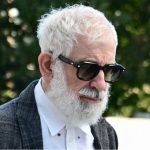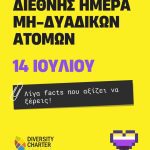The Conference presented and discussed the way in which neurodiverse students perceive school reality, the challenges that teachers face with the new data, as well as strategies that can modify both the environment and the educational process for the benefit of all students.
The event was attended, spoken and coordinated by Konstantinos Tachtsidis , Journalist, Neurodiversity Advocate, Editor-in-Chief of diversitynews.eu, diagnosed with ADHD , as well as Evangelos Theocharis , Global Procurement Director EY (Ernst & Young), Academic, diagnosed with Asperger’s .
The keynote speaker was Erika Tsitimaki , Counseling Psychologist, Psychotherapist and Parent School Coordinator. Nikolaos Kalogeras , Psychologist, Director of JobsLink – Hellenic Association for Asperger Syndrome also participated.

In a full and lively room, it was emphasized that the practical and substantial inclusion of Neurodiversity can only start “from the beginning”. And by saying from the beginning we mean – beyond the home and family itself – from the primary social group of the individual, namely the school. Today’s school class has demonstrably changed its face. It consists of students who differ in the way they perceive, process and manage stimuli and information.
Until now, the way we have managed these differences has been to treat them strictly as disorders. Today we know that neurodiversity is the result of structural variation in the normal genome and the degree to which it affects the functioning of the individual varies. So how can we talk about inclusion if we have not first created a school environment that recognizes, actively supports and effectively supports the needs of all students?
The classroom is a demanding environment designed to cater to a more neurotypical child, and as a result, it is inherently challenging on many levels for neurodiverse children. Loud and unpredictable noises and voices, bright lights, wind, cold or heat, children shouting all at once, create an uncomfortable and stimulating feeling for some children who need to make an extra effort to regain calm and concentration.
The educational process itself, organized to work for the average student population, often creates learning challenges for different minds. They struggle with the way of delivery, with the way and time of assessment, with the pace of providing and examining information, while in many cases there is no space for them to unfold their talents and inclinations. What should school look like for a child with Autism Spectrum Disorder who observes everything closely, needs routines, challenges with social skills and has difficulty with changes, when their schedule is changed without warning, and they shout around them?
How easy is it for a child with Attention Deficit Hyperactivity Disorder to remain still and seated for a long period of time, to wait their turn, to think before speaking, and to maintain their attention in a school context that does not have short and frequent breaks, and is still largely based on memorization and the monotonous and repetitive delivery of the lesson?
Through psychoeducational actions and initiatives such as that of the 1st Athens High School Model, the foundations are being laid for a change and evolution of the educational condition and process that is crucial for children with neurodevelopmental disabilities.
Creating a neurodiversity-affirming classroom is not easy, but even small changes can make a difference. From educating teachers about the challenges of these children so that they can recognize and frame any difficulties, to using new teaching methods and tools, such as experiential and group-centered learning, to using audiovisual media more frequently, to creating quiet spaces within the school environment, to changing the very mindset regarding the neurodiversity classroom, these are just a few of the ways that can lay the foundation for a school environment in which all children feel accepted and safe to showcase their personality and potential.
It is time to admit, to accept that individual differences of students, of people due to neurological diversity do not belong to the stereotypical dichotomy of normal and abnormal expected, right or wrong and to be able to look at the behaviors of our students and their characteristics as differentiations and difficulties that can and should be supported. We do not want to eliminate the difference, we want to frame it, to help it live harmoniously as each person deserves with respect for their uniqueness.











